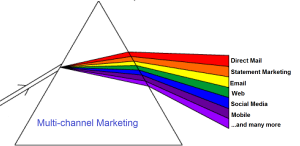The rise of the Internet, the introduction of social media, and continuing changes in search engines, have combined to make the face of marketing nearly unrecognizable after decades of relative stability. In fact, there is not just one face of marketing – there are many. It’s not as simple as saying it is multi-channel because each channel reflects upon the others to create a prismatic effect.
Today, marketing campaigns and overall brands are built by the careful positioning of individual channels to create a larger marketing picture.
Integration Is Key
According to a study conducted by the Kaiser Family Foundation, kids from ages 8 to 18 spend an average of 7.5 hours per day, 7 days per week, using some form of media. And because most of them use two or more types of media simultaneously (i.e. text and video), they’re consuming the equivalent of 11 hours of media content every day.
That’s more than 75 hours of media every week — and that’s not even counting time spent on their computers for school work, or time spent talking or texting on their phones.
This generation has grown up with a mix of media, and naturally expects a variety of channels to choose from. A multi-channel approach is absolutely crucial if you’re trying to attract the younger demographic but you may be surprised at how important certain combinations of channels are to targeting all consumer sectors. The nuances of which social media channels to combine with direct mail and email or text for a particular audience can actually change on a quarterly basis.
The Old Way
Neil McElroy, in a 1931 memo he wrote while working for Proctor & Gamble, introduced the concept of a Brand Manager: a single point of responsibility for the success or failure of a brand, across all of its channels. The problem is, while that model worked when companies only had six relevant media or distribution channels to worry about, today’s dizzying array of channels makes it nearly impossible for one person to have any level of “hands on” involvement or even expertise in each of the individual channels.
And many companies losing control of their brand stewardship. They integrate only a few channels — email, direct mail, the company website, social media, or perhaps print, display, and television — and manage them in various silos throughout the organization. Some of these channels aren’t really managed at all and others are managed in a way that makes it difficult for other channels to maintain consistency (I’m talking to you web people!)
Another problem with McElroy’s approach in today’s environment is that it’s too dependent on historical data — analyzing what consumers have responded to in the past. But with changes coming at a faster and faster pace (for example, Google’s ever-quickening schedule of algorithm updates), it’s more important to focus on the future through predictive analytics.
Past performance is no longer a guarantee of future results. The investment industry has known this for a while.
While it’s still important to have someone in charge and responsible for consistency as McElroy suggests – this needs to be managed in terms of “big rules” that can be translated appropriately for different channels. Those big rules should include recommendations for leveraging various channels in combination to achieve a particular goal. Just as there is a brand palette for corporate colors there needs to be a brand palette for channel combinations.
For example – if you are going to create a direct mail campaign to consumer segment x, the campaign will also include an email component, specific social media channels and a QR code for a customized mobile site. Predictive analysis, along with campaign measurement can be used to rapidly adjust the “big rules” by segment.
Marketing is constantly evolving and the organization of resources and the ability to set strategy that can work across multiple disparate channels continues to be a top challenge for marketers in 2015.



